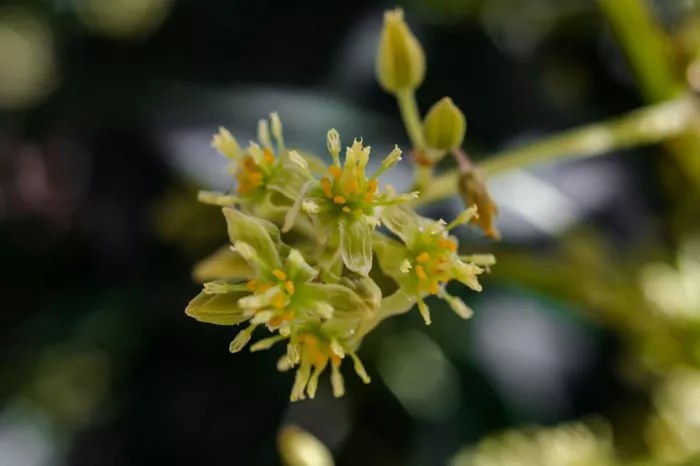Avocado trees (Persea americana) are renowned for their delectable fruits, but their flowers often remain a mystery to many. Understanding the appearance of avocado tree flowers is crucial for growers, botanists, and enthusiasts alike. Not only do these flowers hold aesthetic appeal, but they also play a pivotal role in the reproductive cycle of the avocado tree, ultimately determining fruit yield and quality.
The Anatomy of Avocado Tree Flowers
Avocado tree flowers are small, delicate structures that typically measure around 5-10 millimeters in diameter. They consist of three main parts: the calyx, corolla, and reproductive organs.
1. Calyx: The calyx is the outermost part of the flower and consists of sepals, which are green leaf-like structures that enclose and protect the inner parts of the flower during the bud stage. The sepals are usually fused at the base.
2. Corolla: Inside the calyx lies the corolla, which comprises the petals of the flower. Avocado tree flowers typically have three to four petals that are creamy white or pale yellow in color. These petals may exhibit slight variations in color and shape depending on the avocado variety.
3. Reproductive Organs: At the center of the flower are the reproductive organs, including the stamen and pistil. The stamen is the male reproductive organ, consisting of a slender filament topped by an anther where pollen is produced. The pistil, on the other hand, is the female reproductive organ, comprising the stigma, style, and ovary. The stigma is often located at the tip of the pistil and serves as the receptive surface for pollen grains.
Variability in Flower Structure
While avocado tree flowers share common characteristics, there can be variability in their structure among different avocado cultivars. Factors such as genetics, environmental conditions, and age of the tree can influence the appearance of the flowers.
1. Genetic Variation: Avocado cultivars exhibit genetic diversity, leading to differences in flower morphology. Some cultivars may have larger or smaller flowers, while others may display unique color patterns or petal shapes.
2. Environmental Factors: Environmental conditions such as temperature, humidity, and soil composition can impact flower development and appearance. Extreme weather conditions or nutrient deficiencies may result in abnormalities or irregularities in flower structure.
3. Tree Age: The age of the avocado tree can also affect the appearance of its flowers. Young trees may produce smaller or less developed flowers compared to mature trees. As the tree matures, its flowers may become larger and more abundant.
Seasonal Flowering Patterns
Avocado trees are known to exhibit seasonal flowering patterns, with peak flowering typically occurring during specific times of the year. Understanding these patterns is essential for growers to optimize pollination and fruit set.
1. Spring Flowering: In many regions, avocado trees primarily flower in the spring months, typically from late winter to early summer. Warmer temperatures and longer daylight hours stimulate flower bud development and initiation. Spring flowering is crucial for ensuring adequate pollination and fruit set.
2. Secondary Flowering: Some avocado cultivars may exhibit secondary or off-season flowering, producing flowers at unexpected times of the year. Secondary flowering can occur in response to environmental cues such as rainfall, temperature fluctuations, or stress factors. While secondary flowering may contribute to overall fruit yield, it can also pose challenges for growers in terms of management and pollination.
3. Factors Influencing Flowering: Several factors influence the timing and intensity of avocado tree flowering. These include temperature, rainfall, photoperiod, tree health, and cultural practices such as pruning and fertilization. By monitoring these factors, growers can anticipate flowering events and implement appropriate management strategies to maximize fruit production.
Pollination and Fruit Set
Avocado trees are classified as “A” or “B” types based on their flowering behavior and pollination requirements. Understanding the pollination requirements of different avocado cultivars is essential for ensuring optimal fruit set and yield.
1. Type A Avocado Trees: Type A avocado trees are characterized by flowers that open as female in the morning and become functionally male in the afternoon. These trees are self-pollinating to some extent but benefit from cross-pollination with Type B trees for maximum fruit set. Type A cultivars include ‘Hass,’ ‘Fuerte,’ and ‘Zutano.’
2. Type B Avocado Trees: Type B avocado trees have flowers that open as female in the afternoon and become functionally male the following morning. These trees rely on cross-pollination with Type A trees for effective pollination and fruit set. Type B cultivars include ‘Bacon,’ ‘Reed,’ and ‘Pinkerton.’
3. Pollinator Presence: While avocado trees are capable of self-pollination to some degree, the presence of pollinators such as bees, flies, and beetles enhances pollination efficiency and fruit set. Maintaining healthy pollinator populations within avocado orchards is crucial for ensuring consistent yields and high-quality fruit.
Conclusion
Avocado tree flowers exhibit a unique and intricate structure that plays a vital role in the reproductive process of the avocado tree. Understanding the anatomy, variability, and seasonal patterns of avocado tree flowers is essential for growers, researchers, and enthusiasts seeking to optimize fruit production and quality. By recognizing the factors influencing flowering, implementing appropriate pollination strategies, and fostering a conducive environment for pollinators, growers can maximize yields and sustainably cultivate this beloved fruit for generations to come.


